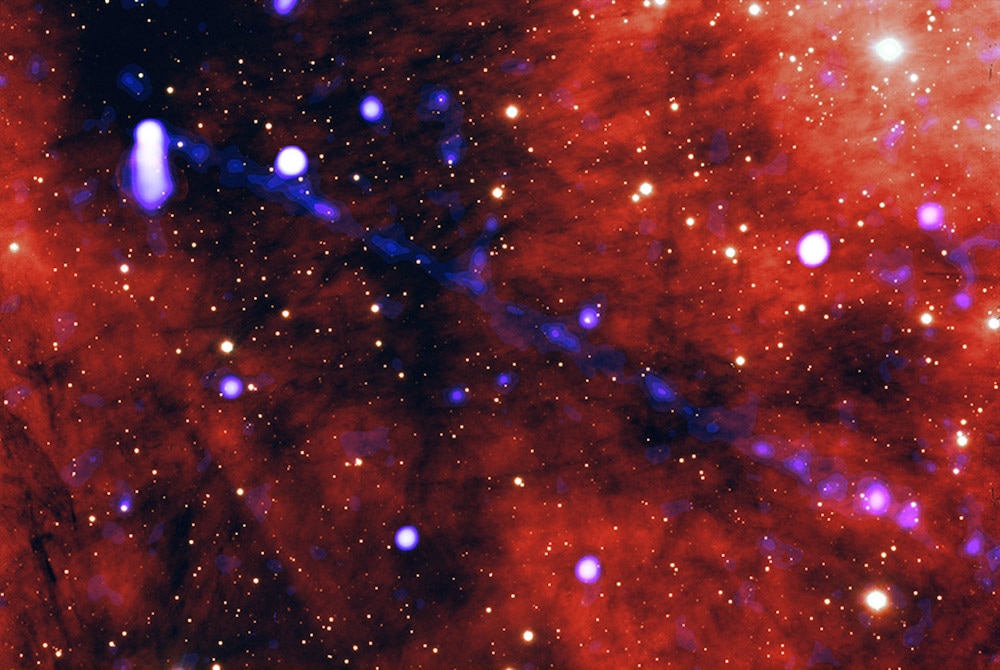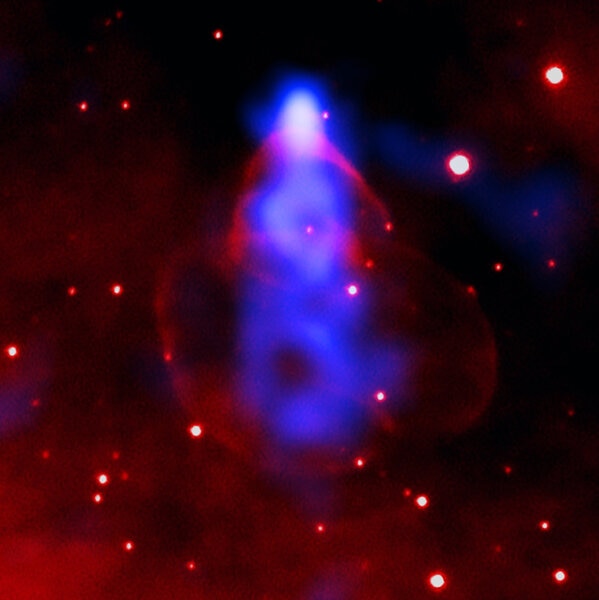Create a free profile to get unlimited access to exclusive videos, sweepstakes, and more!
A pulsar is firing a 7-light-year-long antimatter stream into space
It only gets weirder from there.

There’s an aphorism I’ve seen used here and there which goes, “Nature never draws in a straight line.”
It turns out that’s only mostly true, because sometimes it does, or gets pretty close. For example, a tiny BB of a star just a couple of dozen kilometers across has shot out a pretty straight beam of matter and antimatter that stretches for a staggering 7 light-years — 70 trillion kilometers!
That’s… very long. Even from our distance of 1,600 light-years the beam is half the apparent size of the full Moon on the sky. Very long indeed.
The culprit at the center, or really one end, of this phenomenon is a pulsar called PSR J2030+4415. Pulsars are neutron stars, the incredibly dense corpse of the core of a massive star that exploded as a supernova. The outer layers of the star get blasted away, but the core itself collapses. If the core has less than about three times the Sun’s mass it will become a ball of neutrons very roughly 20 kilometers wide. This makes it ultradense; a cubic centimeter of it — the size of a six-sided die — will have a mass of about 100 million tons, about the same as if you took every car in the United States and crushed them down until all together they were the size of a sugar cube.
Neutron stars tend to spin rapidly, and have powerful magnetic fields that can be trillions of times stronger than Earth’s. This sets up a lot of different phenomena; one is that this powers incredibly strong beams of radiation that blast away from the magnetic poles of the star, which sweep around the sky due to the neutron star’s rotation like a pair of lighthouse beams. When these beams pass over Earth we see a blip of light, a pulse, hence the term pulsar.
The pulsar also blows out a very powerful wind of charged subatomic particles that are accelerated by the ridiculously overmuscled magnetic field. The particles move out at a significant fraction of the speed of light. If there’s gas floating between the stars around the pulsar, this wind will slam into it and create an expanding bubble of gas. If the pulsar is moving relative to that gas the bubble will actually be more of a bow wave, like the wave in water created by the bow of a boat as it moves.
This is exactly what’s seen with several pulsars, including PSR J2030+4415. But in this case, it gets a little more complicated [link to paper]. For some reason the expanding wave in front of the pulsar stalled, and the pulsar’s forward motion actually made it break through the front of the wave. Observations taken over the past 10 years or so indicate this breakout happened only about 20 – 30 years ago! Since then a new bubble has been forming, a small one expanding at the tip of the bow wave.
This is where the fun is. The gas between stars, called the interstellar medium, also has a magnetic field associated with it. The field is very weak, about 1/50,000th as strong as Earth’s field, but it stretches over vast distances, so it has a pretty big effect on the gas.
When the pulsar broke through its own bow wave, its magnetic field could connect directly with the field of the surrounding gas. Interactions like this are extremely complicated, but in the end this resulted in a leak, like puncturing a hole in a high-pressure hose. Subatomic particles from the pulsar wind shot out of this hole and screamed away at about 1/3rd the speed of light, moving out into the interstellar medium.
As they did they interacted with the magnetic field lines of the gas. Charged particles spin around the field lines like beads on a wire, and when they do they emit radiation. At the energies of these particles that comes out as X-rays, and Chandra X-Ray Observatory observations see this as little blobs of light strung out in a straight line 7 light-years long. In a sense they are lighting up a filament, a single magnetic field line in the galaxy, like Christmas lights on a string.
The particles in this case are both electrons and their antimatter equivalent are called positrons, which are just like electrons but have a positive charge.
So what we’re seeing here is a pulsar-driven galactic-magnetic-field-focused beam of matter and antimatter stretching for 70 trillion kilometers and is big enough that we could see it by eye if only our eyes could see X-rays. And that’s just cool.
As it happens, there have been some observations recently showing there are more antimatter positrons hitting Earth’s atmosphere than expected given what we know about astrophysical sources that can create them — to be clear it’s not a danger since it’s a teeny tiny amount, but it’s still weird. It’s possible that pulsars leaking them into the galactic magnetic field in this way could explain the excess. That’s not at all clear just yet, but it’s an interesting idea.
The Universe is an amazing place, with incredible objects imbued with immense power that can create mechanisms and structures that are both strange and understandable… if you know the right math and physics. The cosmos doesn’t make it easy on us to figure these things out, but then that’s part of the fun of it.






























